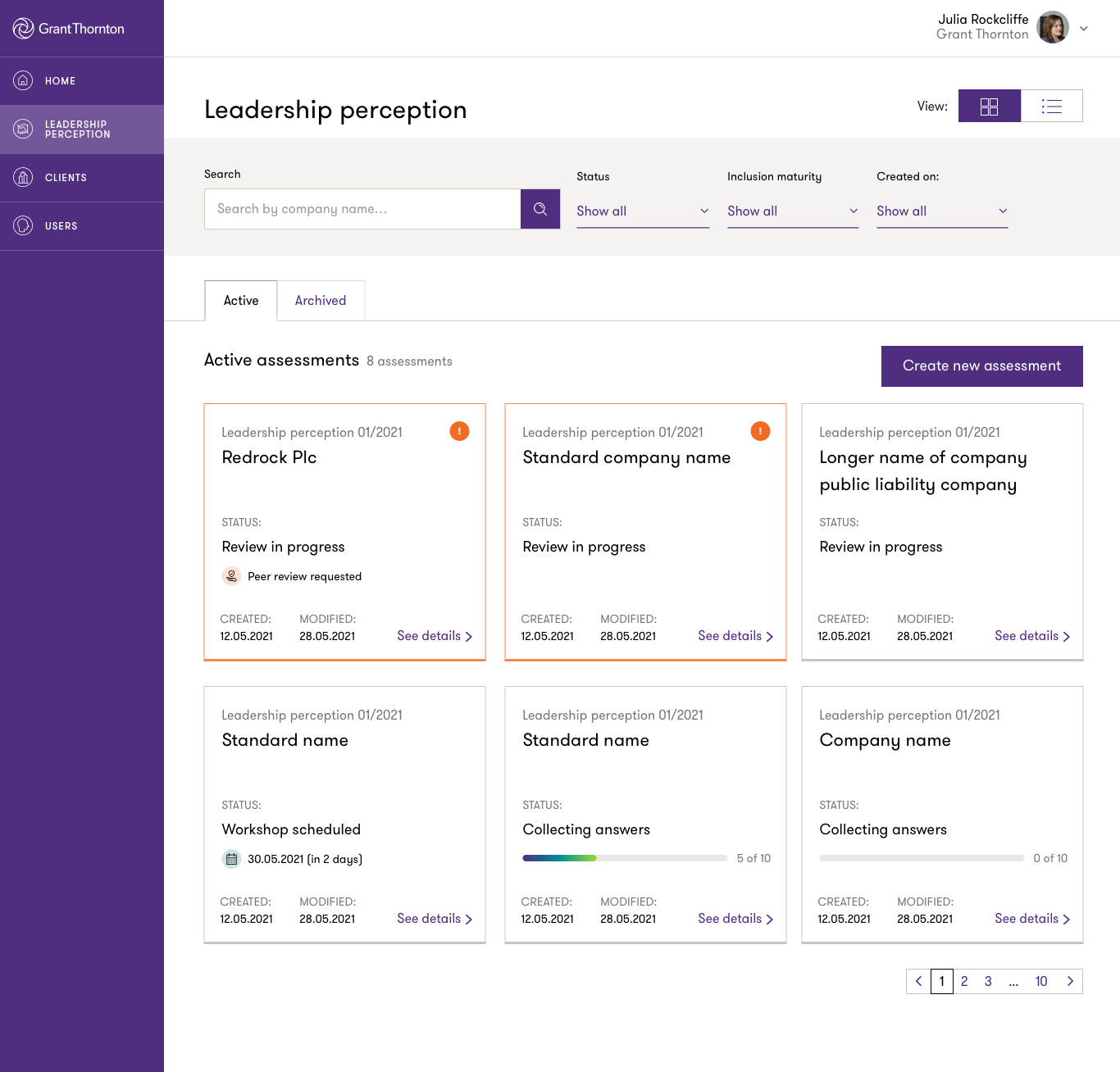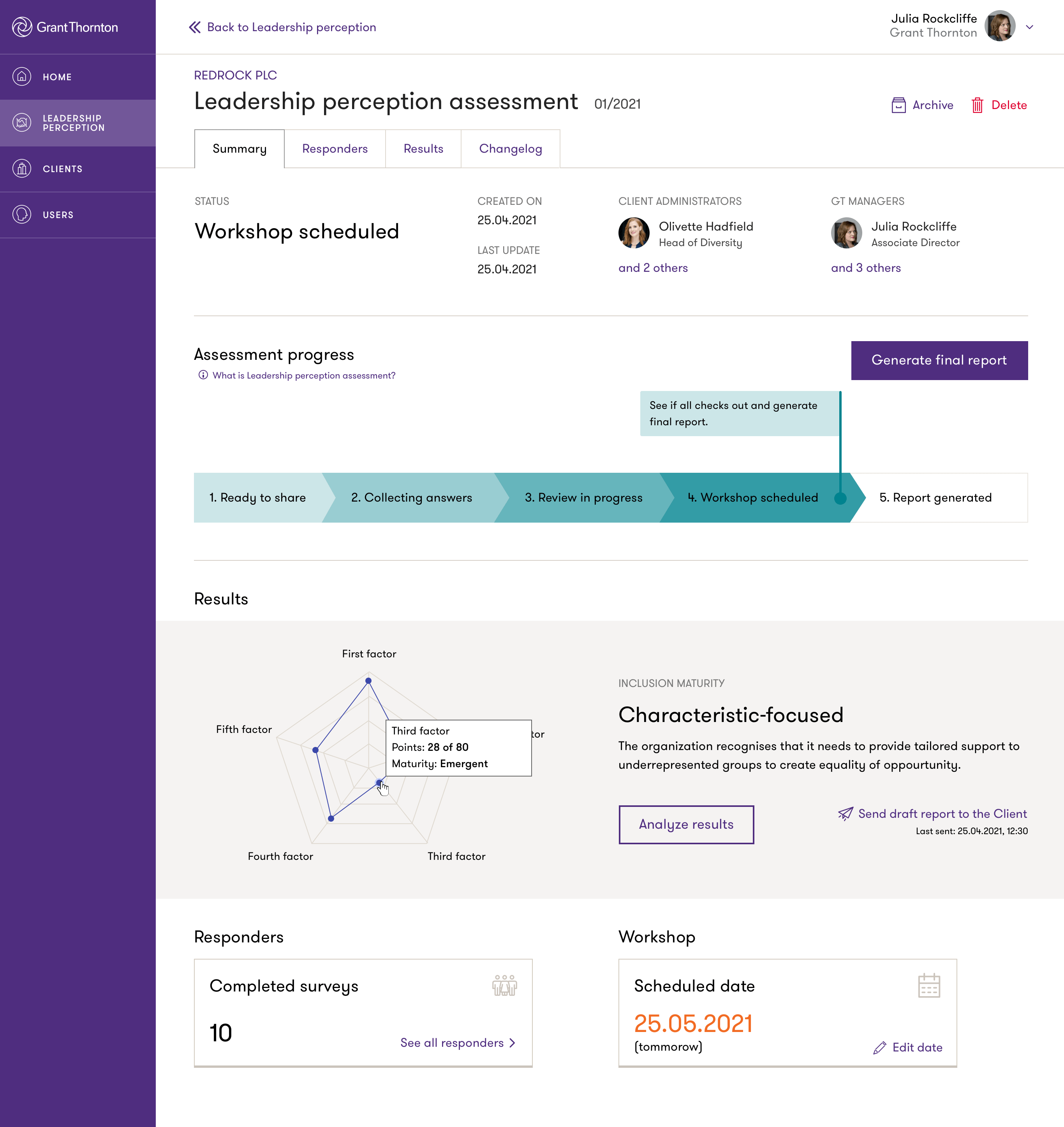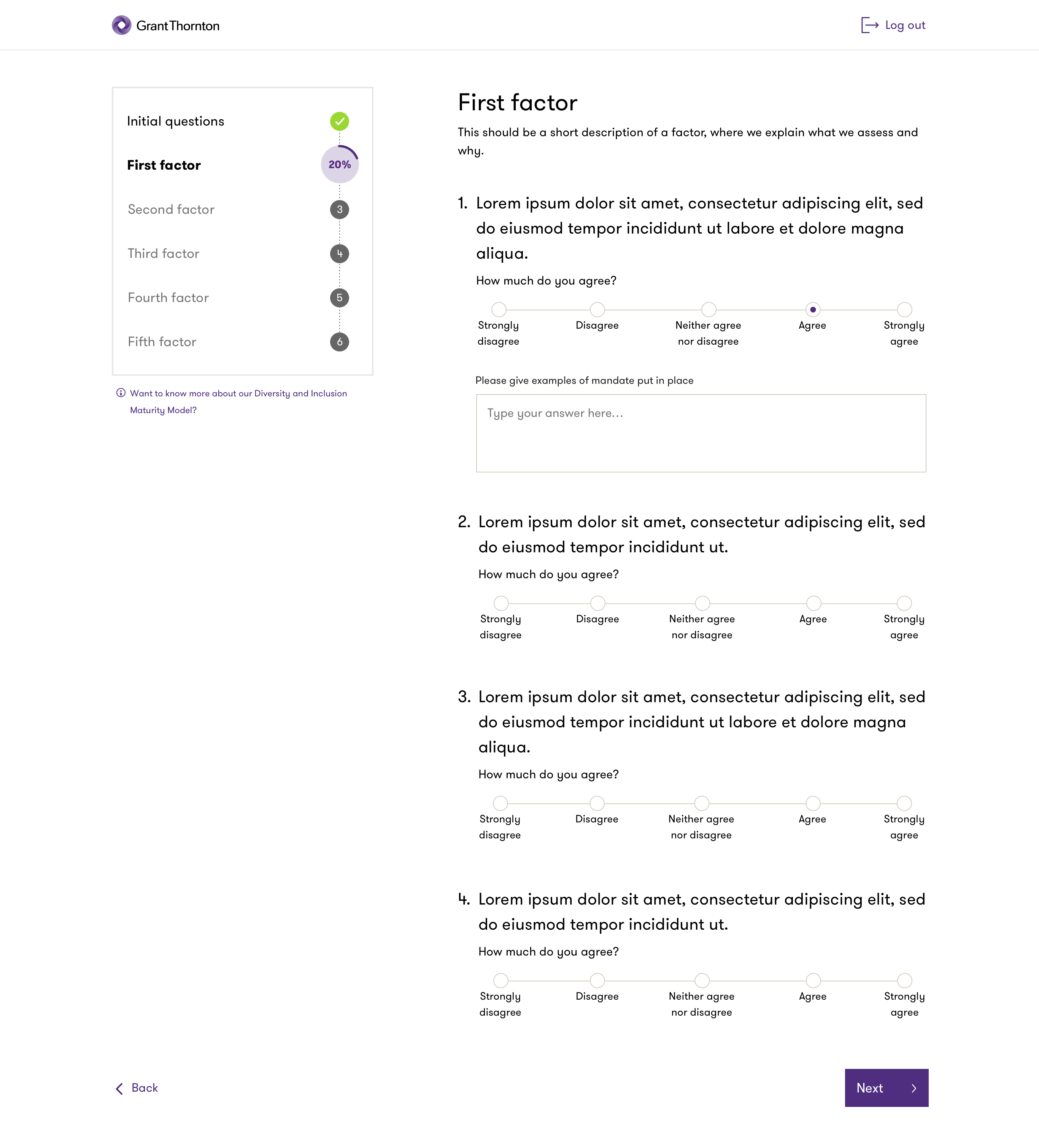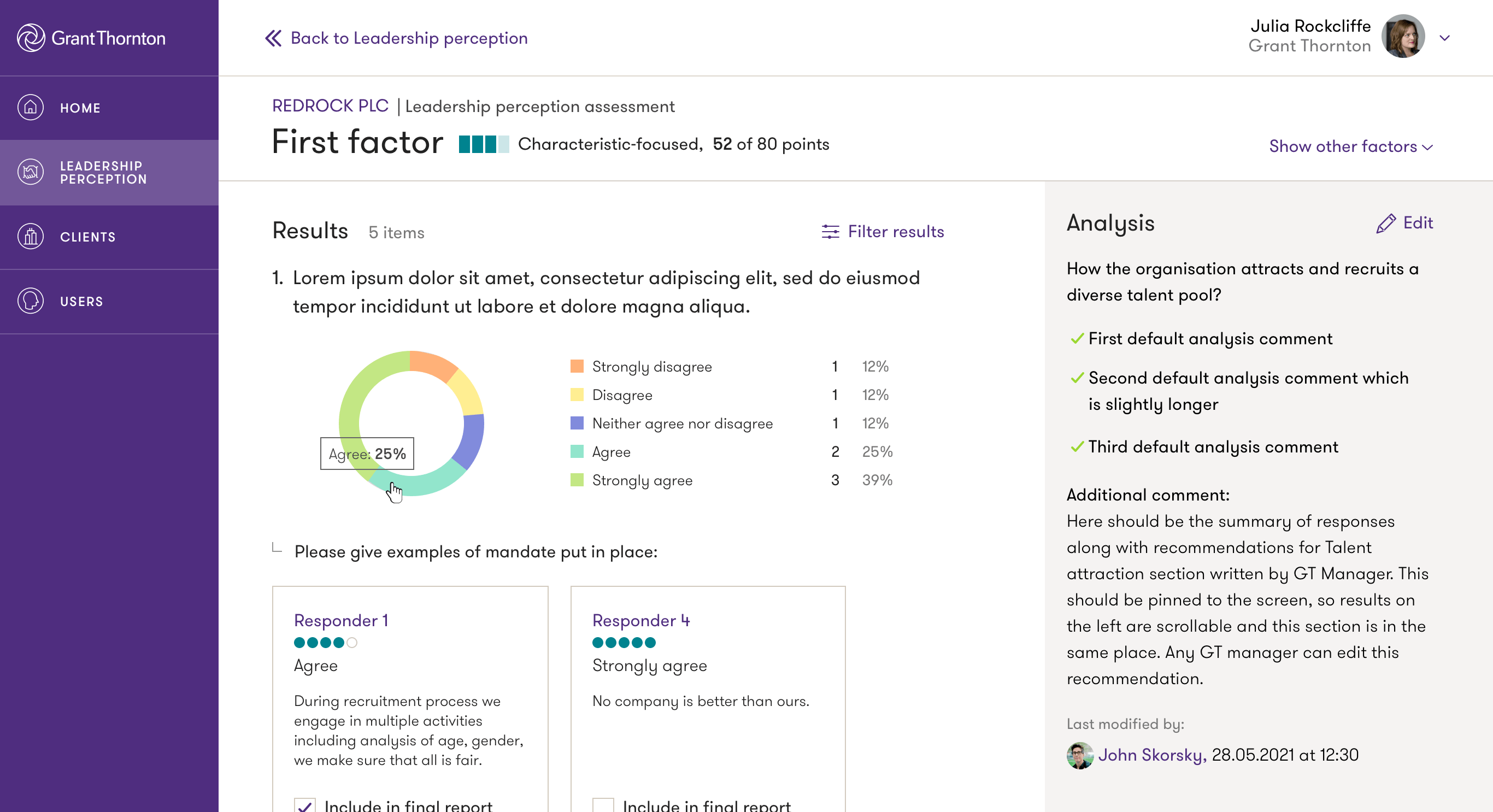Together with the UK member firm of Grant Thornton, we designed an application that allows us to measure and manage the level of diversity and inclusion in the organisation. The application consists of a survey part allowing for anonymous evaluation by employees and a panel for managers, presenting the results of their own organisation.
Why to care about diversity, equity and inclusion?
The importance of inclusion in the workplace is becoming increasingly more important, especially in light of the global pandemic and racial inequality awareness around the world.
Now more than ever, diverse workforces are not just a nice to have but a moral and commercial imperative. Research has shown us for years that where organisations are more diverse, particularly in senior positions, they build competitive advantage through increased innovation, resilience, improved employee attraction, retention and engagement, and greater connection with customers and communities in which they work. However, while improving diversity is important, engaging and retaining a diverse workforce through an inclusive culture, where different perspectives can thrive, is what makes the difference.
Client
Grant Thornton UK LLP is a member of Grant Thornton International, one of the world’s largest professional services networks of independent accounting and consulting member firms. They go beyond to combine global scale with local insight that leverages their technical expertise to deliver practical guidance in assurance, tax, and advisory services.
The firm are committed to building diverse teams that reflect society and the clients they serve. They also want to build a culture of belonging and inclusion, where people feel able to be themselves and to bring their whole selves to work. They are seeing strong progress from employee feedback as well as external recognition including consistently being in the top 10 of the Social Mobility Employers Index since 2017, being named as a 2021 Top 10 employer for Working Families, pledging commitment to the Race at Work Charter, HM Treasury Women in Finance Charter and the Valuable 500 disability pledge, as well as being a Stonewall diversity champion.
The firm have used this experience to support clients to make their own progress towards building a truly inclusive culture using their Inclusion Maturity Model.
Background
Grant Thornton UK LLP’s Inclusion Maturity Model enables organisations to get an objective sense of where they are on their inclusion journey, understand their ambitions, develop a data-led strategy, and implement focused interventions to ensure they realise that ambition.
The approach starts with getting to know the client and assessing the current inclusion position through various data points. Grant Thornton UK LLP’s Inclusion and Diversity specialists then provide recommendations to reach their inclusion ambitions. Our goal was to transfer these offline processes onto a digital platform and make the assessment more efficient and accessible for both the Grant Thornton UK LLP team and their clients.
Challenge – measuring diversity and inclusion
Experience shows that lasting change starts from the top through committed actions and, importantly, role-modelling behaviours that support an inclusive culture. Leadership teams across many organisations are still not representative of how diverse their workforce or community is. Therefore, there is a need to understand the perceptions of the leadership team along with their ambitions for inclusion, ahead of engaging in further work.
By breaking down barriers and creating challenge in a supportive environment Grant Thornton UK LLP can work with leadership teams to create a change roadmap that they and the organisation can get behind.
The firm wanted to create an initial version of the Inclusion Maturity platform that enables anonymous perception surveys to be carried out among the leadership team within an organisation.
It was important to Grant Thornton UK LLP that:
- The results are impactful and lead to appropriate actions through compact, intuitive, and well-designed dashboards and reports
- Data protection laws are adhered to and respondents re-assured that their data is safe
- To provide the client with ownership of the platform, e.g. manage the respondents activity throughout the lifecycle of the assessment and to allow for periodic assessments and a basis for comparison
- Tracking of assessment progress, automatic analysis of the results and both automatic and manual report writing
- Clear view of multiple assessments/ clients at the same time for easy project management by Grant Thornton UK LLP’s specialists
How does the design process look like?
Kick off
Knowledge sharing and defining business goals
Discovery sprint
Describing the process and user journeys
Concept
Initial screens of the application
Detailed design
Mapping all necessary functionality with mockups
Implementation support
Coordinating the work of engineers
Testing and further development
Quality assurance and roadmap for future development
First step – discovery workshop and scoping
Our design process started with gathering product requirements and understanding current solutions. We met with Grant Thornton UK LLP’s specialists to discuss how the Inclusion Maturity Model works, the current pain points of assessment process and key value drivers.
As a result, we mapped the whole process to translate it into screens in the platform, considering three – very different – perspectives:
- Specialists from Grant Thornton UK LLP (including manager and admin) who create the assessment, analyse the results, and prepare recommendations,
- A client administrator who invites their management team to complete the assessment and has access to the results and recommendations,
- A respondent who can fill out an anonymous survey, without creating an account in the system.
We showed all steps as blocks and marked the connections between them to visualize user flows and understand the business logic and potential passages between different screens and sections in the system.
We then conducted domain analysis and defined the business objects and relationships between them, to define the hierarchy of the elements. Next, we gathered all the ideas for functionalities and prioritised them by value to business and users, along with the effort for the development team. This allowed us to create scope and requirements for the MVP version of the platform.
Discovery sprint
Make your product concept tangible with 2-weeks design thinking process.
Concept – mapping crucial functionalities
After several workshops, we were ready to model the concept and create the information architecture diagram based on the user flows and mapped business objects. Each role had unique architecture reflecting different needs and specific context.
We created diagrams with key categories and sub-categories in the system, with a distinction of the specific needs of Grant Thornton UK LLP and Client users, including different roles and limited access to specific sections of the system. Then we described all roles in the system to create a detailed specification for sets of privileges and access rights.
Having all the necessary details and structure of the system mapped, we were ready to create mockups and visual screen flow with multiple scenarios and notes for the development team.
Example dashboard and survey summary screens
See what you need when you need it
Our main goal was to simplify steps, walk the users through and suggest possible areas of improvement to move the assessment forward.
We wanted to make both Grant Thornton UK LLP specialists and Client users aware of the full process, show them where they were in the process and what needed to be done next. This resulted in creating tailored views for every role so that all users involved in the assessment are aware of their respective activities and progress, without any privacy violation
We divided the whole scope of the project into 4 sprints, and after every week we presented and discussed the effects of our work with the UK team, implemented adjustments, and handed designs over for development. This continuous close cooperation between business, design, and development teams allowed an iterative approach and dynamic progress.
Leveraging the Amethyst design system
To fully cover all functionalities and roles we had to provide the development team with quite a lot of different modules and elements, but the work went very smoothly. We designed nearly 80 unique screens within just 1 month thanks to using the dedicated design system. The Amethyst design library, which was created by us and is used for all Grant Thornton projects, allows us to deliver the products quicker and keep them very consistent. It also helps developers to streamline and optimise front-end implementation.
This UI framework and library of components allowed us to prepare high-fidelity mockups much quicker and at the same time we were sure that all components met principles of accessibility. We used UI elements as bricks, followed the specific guidelines, and were able to show all views of the platform instantly with its look and feel, skipping the traditional distinction between wireframes and UI/layouts.
The design system also contains the code snippets for developers, which was easier to implement and made the new system consistent with other Grant Thornton solutions to fit the whole ecosystem.
Key features and solutions
The key assumptions and patterns that allowed us to deliver the optimal experience for all groups of users were:
- clear summary of the whole process for every user,
- tracking assessment progress, the status of assessment, and completion rate,
- anonymous, easy to fill surveys, secured by the individual code, and with automatically saved progress,
- interactive charts and comprehensive visualization of all results to convey the results to the managerial team
- contextual hints to show the right information at the right time,
- easy to apply filters for quicker analysis and the possibility to cut out some data,
- customized reports with comments from specialists, possibility to use predefined recommendations, and include anonymous examples of responses to support recommendations,
- helpful email notifications with a clear call to action,
- the function of peer review to quickly double-check the analysis within Grant Thornton UK LLP, before sending the final results to the Client.
Development & continuous support
Once we accomplished the design part, we were still supporting the development and business teams to ensure the highest quality of the product. We advise on the new paths, gather user feedback and ideas for further growth of the platform, and conduct implementation audits after every implementation sprint.








